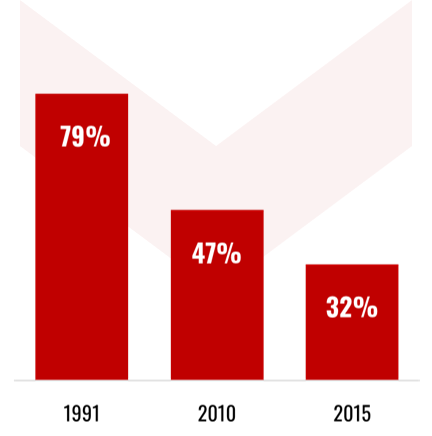Marijuana Use by Teens and Young Adults

Believe it or not, your teenage years and early 20’s are a critical period for brain development. In fact, the brain does reach complete maturity until about age 25. This means that young adults are particularly susceptible to the negative consequences marijuana may have on maximizing cognitive function and learning ability.
If you’re a young adult who has been using marijuana frequently, or the parent of a young adult who uses marijuana, it’s important to be aware of the risks of marijuana. Here, we’ll discuss some of the effects, warning signs of problematic use, and treatment options available for teens who are heavy weed users.
Effect on Developing Brain
High levels of marijuana use in young adulthood are associated with poorer educational outcomes, lower income, higher levels of unemployment, lower relationship satisfaction, and lower overall satisfaction with life, as well as increased violent and criminal behavior and use of other illicit drugs (Fergusson and Boden, Addiction, 2008). However, these are simply associations, and don’t necessarily point to a causal connection between early marijuana use and any of these outcomes.
At the same time, there is more robust evidence to support that developing an early marijuana habit has long-lasting impacts on your brain function. Intensive neuropsychological testing shows that long-term use of marijuana can result in a significant decline in executive functioning, memory, learning, and cognitive processing speed. Significant declines in IQ (intelligence quotients) have been reported in studies of marijuana-dependent adolescents who are followed over time (Meier, PNAS, 2012). In contrast, no such declines are observed in those who started using marijuana as adults. Additionally, greater declines in IQ were found in people who began to use marijuana use at a young age compared to those who started using marijuana later in life (Pope, Drug Alcohol Depend, 2003).
Marijuana’s direct impact on brain structure and function are further supported by brain imaging studies (Jacobus, Curr Pharm Des, 2014). Certain brain regions important for memory and attention, like the hippocampus, prefrontal cortex, amygdala, and cerebellum, have been shown to be the most heavily affected by regular marijuana use among heavy users of the drug. These changes in activity were associated with higher average doses and earlier age of first use, supporting the notion of a “dose-dependent” relationship between marijuana use and long-term impacts on neural function.
Warning Signs
Becoming familiar with the signs of excessive marijuana use can be helpful for several reasons. Your teenage years are a period of intense emotional, intellectual, and physical transitions. As if that’s not enough, you begin to grapple with questions about identity and belonging, like finding out you are and your place in the world.
All of this is simply to say that the signs of marijuana use and abuse in adolescents are therefore oftentimes subtle, and manifest in nonspecific ways. If you’re a young person struggling with your relationship with marijuana, or a parent that suspects your teen is using marijuana, here are some things to look out for:
- Symptoms of marijuana withdrawal during periods of abstinence
- Mood changes, such as irritability, anger, or anxiety
- Lower energy levels
- Change of interest in activities or appearance
- Problems remembering or concentrating
- Red or bloodshot eyes
- Problems with behavior or grades at school
- Slowed reaction times
- Finding or smelling marijuana or marijuana-related accessories, such as pipes, joints, vaporizers, cartridges, and oils
Talking to Young Adults About Heavy Use
If you discover or suspect that your teen is a regular, heavy user of marijuana, consider taking steps to discuss their use. A helpful starting place is often laying the groundwork for an open, honest, and respectful conversation where you can ask how much and how often they’ve been using marijuana.
If you’re a marijuana user, initiating a conversation about your marijuana habits may be the last thing that you want—criticisms can oftentimes seem hurtful, or unjustified. Remember, though, that from the other end, broaching the topic of possible marijuana use or addiction with someone you care for can be incredibly daunting. The persons who choose to voice their concerns are people who truly care about you. When talking about possible marijuana use, keep these principles in mind:
- Have an open discussion: preventative conversations should never be interrogations, or one-sided. When people are criticized, their natural reaction is to put up a defense, or perhaps even to lash back. Remember that the goal is not to win, but to listen.
- Put yourself in the other person’s shoes: if you’re a loved one who wants to broach the topic of marijuana use with someone you are worried about, keep in mind how off-putting it may be if you catch someone off guard with uninvited opinions. Build trust and demonstrate empathy by trying to understand the other person’s experience through questions like What do you think about what I said? What have you been going through?
- Help each other to optimize supportive environments and lifestyles: prevention of marijuana abuse isn’t about squashing habits whenever they start to boil over. Our social, physical, and mental environments play a huge role in influencing our personal behaviors. If you live with someone who has a worrisome pattern of marijuana use, try and identify those lifestyle factors which create opportunities—or drive—to use, whether it’s boredom, stress, or a particular social crowd.
Elsewhere on this website, we discuss treatment options for marijuana addiction and cannabis use disorder.
Statistics
Marijuana use predominates in youths compared to older populations and is the most commonly used substance among adolescents and young adults (Johnston, NIDA, 2012). Young adults represent about one-third of all people who use cannabis (Center for Behavioral Health Statistics and Quality, 2017) and are also more likely than older adults to become addicted to marijuana. The lifetime risk of dependence in marijuana users is less than 10 in 100; however, this risk increases to around 16 in 100 in people who start using as teens (Hall and Degenhardt, Lancet, 2009).
Growing marijuana use among young people is explained in part by a declining perception of harm associated with marijuana, especially amongst young people. In 2015, only 32% of high school seniors thought marijuana use was risky compared to 47% of seniors in 2010, and 79% in 1991 (Weiss, Int J Drug Policy, 2017).
12th Graders Who Viewed Regular Cannabis Use as Risky

32% of 12th graders perceived regular cannabis use as risky in 2015 compared to 47% in 2010 and 79% in 1991.